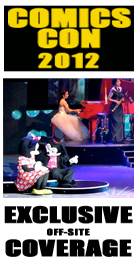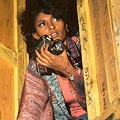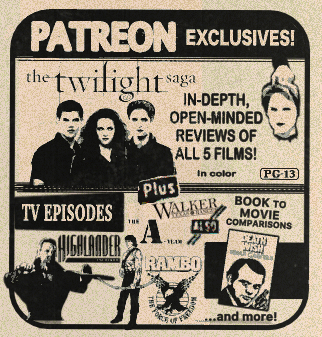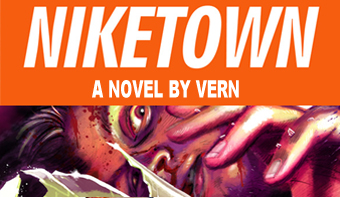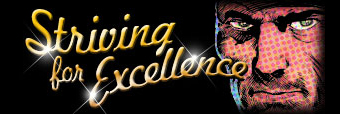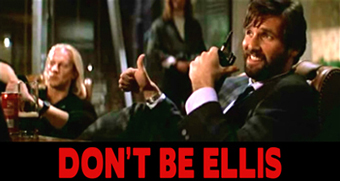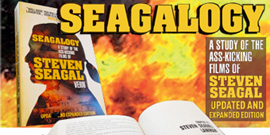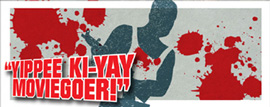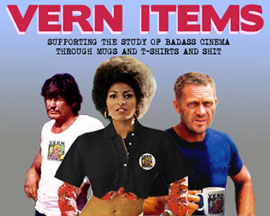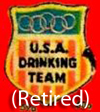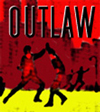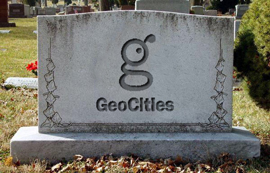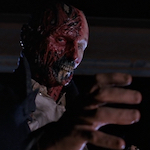 After his horror breakthrough, his failed comedy, and his knockout horror sequel, Sam Raimi finally made it to the semi-big-time. He’d really wanted to do a movie of Batman or The Shadow, but could never get the rights. Then he came up with the idea for his own dark avenger, one with the ability to change his face. His 40-page treatment The Darkman was greenlit by Universal Studios in 1987.
After his horror breakthrough, his failed comedy, and his knockout horror sequel, Sam Raimi finally made it to the semi-big-time. He’d really wanted to do a movie of Batman or The Shadow, but could never get the rights. Then he came up with the idea for his own dark avenger, one with the ability to change his face. His 40-page treatment The Darkman was greenlit by Universal Studios in 1987.
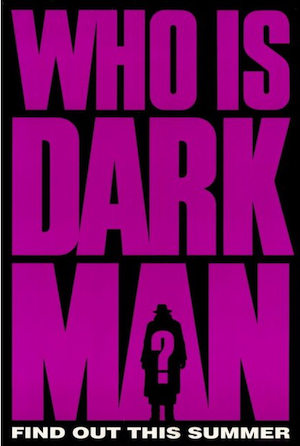 Raimi brought in NAVY SEALS writer Chuck Pfarrer to flesh out the treatment as a screenplay, which was then rewritten by Raimi and his brother Ivan (under the theory that Ivan, a doctor, could help make the medical sci-fi aspects plausible). The studio brought in the team of Daniel and Joshua Goldin (up-and-comers they also had working on PROBLEM CHILD) to bring the various drafts together before the Raimis went at it again. By the time the movie was made and released at the end of August, 1990, Tim Burton had made his BATMAN movie and all the studios were trying to mimic that success. Surely that was an influence on Raimi’s choice of composer Danny Elfman, and on the minimalist marketing campaign based around a silhouette and the question “Who is Darkman?”
Raimi brought in NAVY SEALS writer Chuck Pfarrer to flesh out the treatment as a screenplay, which was then rewritten by Raimi and his brother Ivan (under the theory that Ivan, a doctor, could help make the medical sci-fi aspects plausible). The studio brought in the team of Daniel and Joshua Goldin (up-and-comers they also had working on PROBLEM CHILD) to bring the various drafts together before the Raimis went at it again. By the time the movie was made and released at the end of August, 1990, Tim Burton had made his BATMAN movie and all the studios were trying to mimic that success. Surely that was an influence on Raimi’s choice of composer Danny Elfman, and on the minimalist marketing campaign based around a silhouette and the question “Who is Darkman?”
I’m sure at the time I would’ve been interested in this movie anyway, but I was specifically excited when I read that it was the genius behind beloved video favorite EVIL DEAD II taking his first shot at a large scale mainstream movie. Seeing the posters, reading about it in magazines, seeing it on the big screen, I accepted it as a big time summer blockbuster alongside DICK TRACY, BACK TO THE FUTURE III and DIE HARD 2. But Raimi having four times his budget on EVIL DEAD II still meant about a third or a fourth of the budgets of those films. Even Cannon’s DELTA FORCE 2, released the same day as DARKMAN, had a slightly higher budget. I think it’s a testament to Raimi’s exciting directorial style that his many green screen and miniature techniques, which have dated technically more than any of those other movies, still seemed flashy enough to stand toe-to-toe with them. (read the rest of this shit…)

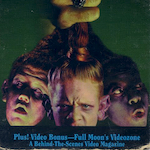 Richard Elfman is the son of novelist Clare Elfman. He grew up in L.A., then worked as an Afro-Latin percussionist in the San Francisco musical theater troupe The Cockettes before moving to Paris to perform, and later returning to form the “commedia dell’arte ensemble” or “surrealist street theatre troupe” The Mystic Knights of the Oingo Boingo. They performed Cab Calloway covers and Russian ballet songs in whiteface, won an episode of The Gong Show, released a doo wop song about the kidnapping of Patty Hearst, and played demons in a hallucination scene in I NEVER PROMISED YOU A ROSE GARDEN. In the late ‘70s Elfman turned filmmaker, directing the Mystic Knights’ black and white cult musical FORBIDDEN ZONE (released in 1982).
Richard Elfman is the son of novelist Clare Elfman. He grew up in L.A., then worked as an Afro-Latin percussionist in the San Francisco musical theater troupe The Cockettes before moving to Paris to perform, and later returning to form the “commedia dell’arte ensemble” or “surrealist street theatre troupe” The Mystic Knights of the Oingo Boingo. They performed Cab Calloway covers and Russian ballet songs in whiteface, won an episode of The Gong Show, released a doo wop song about the kidnapping of Patty Hearst, and played demons in a hallucination scene in I NEVER PROMISED YOU A ROSE GARDEN. In the late ‘70s Elfman turned filmmaker, directing the Mystic Knights’ black and white cult musical FORBIDDEN ZONE (released in 1982).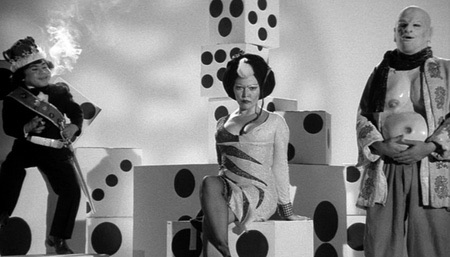 It’s a pretty obnoxious and completely amazing movie, filmed on theatrical sets beautifully designed in a German expressionist/Max Fleischer cartoon style (and sometimes noticeably made of paper). It’s a short but unrelenting burlesque nightmare of tap dancing frogs and skeletons, adults dressed as children and/or only wearing underwear, lots of Mickey Mouse ears, fezzes and boobs, every single character (and there are tons of them) a weirdo or a grotesque caricature. They move bizarrely and at fast speed, lip sync to old timey big band jazz tunes, simulate humping. It stylishly switches to animation as they plummet to Hell or through the intestine shaped tunnel from the Hercules family’s basement to the Sixth Dimension, which is ruled by Susan Tyrrell as the Cruella-meets-drag-queen Queen Doris, and Herve Villechaize as her cheating husband King Fausto.
It’s a pretty obnoxious and completely amazing movie, filmed on theatrical sets beautifully designed in a German expressionist/Max Fleischer cartoon style (and sometimes noticeably made of paper). It’s a short but unrelenting burlesque nightmare of tap dancing frogs and skeletons, adults dressed as children and/or only wearing underwear, lots of Mickey Mouse ears, fezzes and boobs, every single character (and there are tons of them) a weirdo or a grotesque caricature. They move bizarrely and at fast speed, lip sync to old timey big band jazz tunes, simulate humping. It stylishly switches to animation as they plummet to Hell or through the intestine shaped tunnel from the Hercules family’s basement to the Sixth Dimension, which is ruled by Susan Tyrrell as the Cruella-meets-drag-queen Queen Doris, and Herve Villechaize as her cheating husband King Fausto.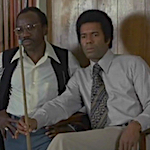 TROUBLE MAN is a solid tough guy movie from the early ‘70s Black action cinema movement. Director Ivan Dixon was an actor (PORGY AND BESS, A RAISIN IN THE SUN, NOTHING BUT A MAN) turned TV director (The Bill Cosby Show, Room 222, Mod Squad) making his first theatrical feature. He followed this with the much more politically radical
TROUBLE MAN is a solid tough guy movie from the early ‘70s Black action cinema movement. Director Ivan Dixon was an actor (PORGY AND BESS, A RAISIN IN THE SUN, NOTHING BUT A MAN) turned TV director (The Bill Cosby Show, Room 222, Mod Squad) making his first theatrical feature. He followed this with the much more politically radical 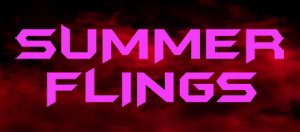
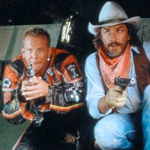 August 23, 1991
August 23, 1991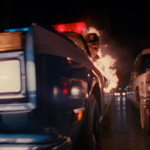 In the tradition of
In the tradition of 